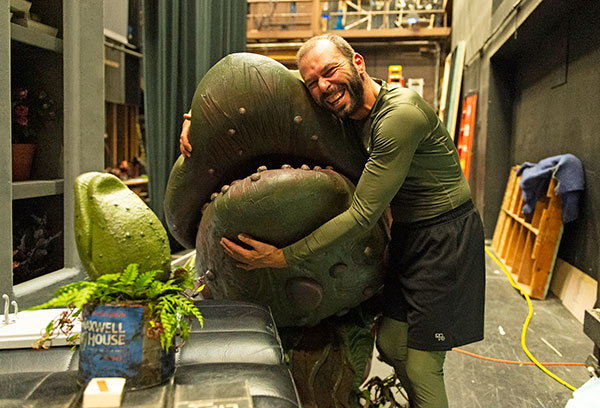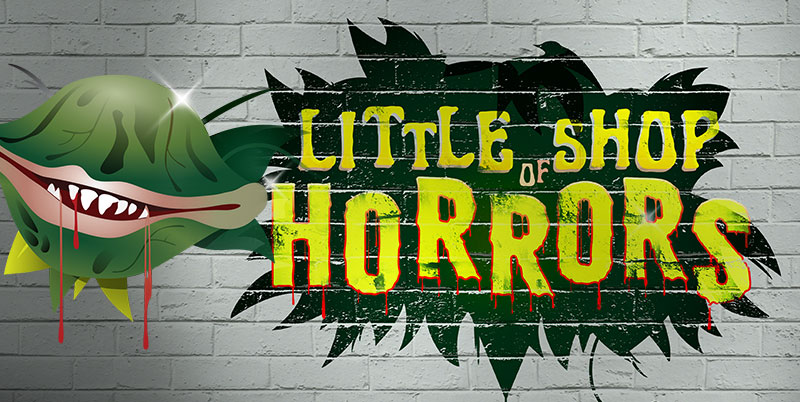By Brian Robin
The Art of Being Invisible—Puppeteering
SCR Artistic/Audience Engagement Associate H. Adam Harris goes on the road to bring you the story behind Little Shop of Horrors.
To Joe Gallina, being a puppeteer is the artistic equivalent of an umpire in baseball or a referee in other sports.
“The point of being a puppeteer is, if people don’t notice you, you’ve done your job. You should be invisible,” Gallina said.
Gallina may be invisible during Little Shop of Horrors, but you’ll easily see his handiwork—and body work—as the manipulator of most of the incarnations of Audrey II, the predatory plant of Little Shop of Horrors. The popular cult classic is performing now and runs through Oct. 19 on the Segerstrom Stage.
Gallina operates three of the production’s four puppets, including “Pod 4,” the largest and final Audrey II. He just performed Audrey II over the summer for the PCPA production, which makes his transition not only seamless, but satisfying for a veteran puppeteer.
“There’s a specificity and genius behind the build of these puppets. These puppets have such an edge to them, they’re more angular and more reptilian. They’re scarier than the ones I’ve worked with before,” he said. “Every time this show is done, the puppets seem to be different. That’s a challenge for a puppeteer. You’re working the same set-up, but how the puppets breathe and move is different every time. It takes a while to wrap your head around it.”
 Gallina uses the word “breath” a lot when discussing his puppeteering. When he teaches puppeteering workshops, Gallina will ask his students what’s the difference between a puppet and a prop.
Gallina uses the word “breath” a lot when discussing his puppeteering. When he teaches puppeteering workshops, Gallina will ask his students what’s the difference between a puppet and a prop.
“The answer is the puppet has a breath. It actually breathes. It lives. It can talk and it has a point of view. It has its own life,” he said.
And that presents a challenge. Gallina has to learn the intricacies of making that puppet come to live—times three. Each of the Audrey II puppets he operates has its own breath, its own range of motion and its own mechanical intricacies and demands.
As an actor or singer, you get external feedback on your performance. When you’re inside a puppet, it’s like wearing a mask. You often don’t see the feedback necessary to seamlessly pull off your role.
“Everything is choreographed and you have to be specific, because any extraneous movement blocks the specificity of what I’m trying to do with the puppet,” he said. “For example, when I’m moving the mouth of Pod 4 (the biggest Audrey II), it takes more time to move that mouth than Pod 3. Pod 3 can talk quick and it’s a different breath for those two puppets even though they’re the same character. That’s been my challenge.
“The bigger the puppet is, the bigger breath it needs and the more time it takes to get the motion right.”
Gallina found his way to puppetry through the Fine Arts department at the University of Connecticut, the only university in North America that has a school of puppetry. Several of Gallina’s friends were puppeteers and one day during his lunch break as a ticket representative at Roundabout Theatre Company, he answered a friend’s call for a puppeteer at the Gotham Chamber Opera.
“I auditioned during my lunch break, they offered me a job there and I got to go quit my day job afterward,” he said. “Every actor dreams of doing that.”
Gallina is more animated than his puppets. He loves what he does and can’t wait to tell you how he does it. Just as long as you don’t see him do it.
“What makes it go to the next level is the puppets seeming like a human can’t be controlling that,” he said. “If you’re going, ‘Is that animatronic,' and when people can’t figure out there’s a dude in the big plastic thing, then I’ve done my job.”
See Gallina’s excellent work and the rest of the talented cast of Little Shop of Horrors on the Segerstrom Stage.



